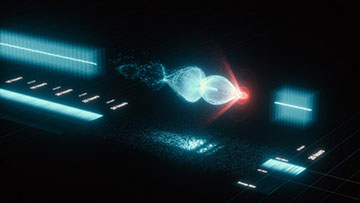
Researchers in Germany have operated a laser-plasma accelerator continuously for more than 24 hours, feeding more than 100,000 laser pulses (red) into hydrogen gas one after another and rapidly accelerating electrons on the resulting plasma waves (blue). [Image: DESY, Science Communication Lab]
Plasma technology has the potential to reduce the size and cost of particle accelerators many times over compared with conventional radiofrequency cavities. To date, however, scientists have been unable to demonstrate plasma devices that can accelerate beams of particles—generally electrons—with specific parameters for extended periods.
Now, reportedly for the first time, researchers in Germany have operated a laser-plasma accelerator continuously and stably over a roughly 24-hour period. In the process, they have shown that they can map variations in the electron parameters to those of the laser beam—a capability that could in future allow the performance of plasma accelerators to be actively controlled (Phys. Rev. X, doi: 10.1103/PhysRevX.10.031039).
Work in progress
Laser-plasma accelerators exploit the very strong electric fields that intense laser pulses can create in their wake as they zip through a gas. Each passing pulse ionizes the gas and pushes freed-up electrons away from its axis of travel, leaving a region of positive charge behind it. As those electrons bounce back and create a net negative charge, another positive region gets set up further down the line. This creates a charge wave that other electrons, whether from within the plasma itself or injected from outside, can in effect surf to reach very high energies.
Such devices regularly achieve accelerating gradients of several hundred gigavolts per meter—compared with just a few tens of megavolts per meter possible with radiofrequency machines. This disparity implies that the length of the highest-energy particle accelerators could in principle be reduced from kilometers to centimeters—potentially enabling very compact sources of X-rays (by using magnets to “wiggle” the energetic electrons), or, perhaps, smaller and cheaper colliders for high-energy research.
However, plasma accelerators are still a work in progress. As Andreas Maier and colleagues at the University of Hamburg and the Deutsches Elektronen-Synchrotron (DESY) point out, experiments have shown how these accelerators can generate electron beams with high brightness, low emittance and pulses lasting just a few femtoseconds. But, they say, “it is still a major challenge to produce those beams reliably and reproducibly.”
Three parameters
In the latest work, Maier and co-workers aimed to better understand how plasma accelerators can be tuned to generate high-quality electron beams. For that they needed lots of data, and used an accelerator known as LUX that they built at the DESY laboratory, also in Hamburg. They were able to generate electrons with several hundred MeV by firing 2-J, 42-fs laser pulses into a sapphire crystal fed continuously with nitrogen-doped hydrogen, and then separate out the laser pulses from the accelerated electrons to measure their parameters separately.
The researchers ran the accelerator continuously for a little over a day, generating one electron beam every second for a total of more than 100,000 beams. With two-hours’ worth of those data, they first established which of the many laser parameters had the greatest bearing on the electrons' energy. They found that there were three such parameters, with the laser's energy unsurprisingly being one of them, and the other two relating to the spatio-temporal properties of the laser pulses.
With this information in hand the researchers were then able to predict how the electrons’ energy would drift by monitoring the three parameters in question. Using a rolling average of electron energy over a six-minute window, they found that they could predict the variation in that energy to within a fraction of a percentage point of the measured values over periods of up to six hours. They were then able to extend their predictions over longer periods by recalibrating their correlations every few hours.
Toward application-ready performance
Maier and colleagues conclude that the three laser parameters they identified are indeed chiefly responsible for the drift. They say that they could in principle eliminate that drift by continuously monitoring and adjusting those parameters, which, they argue, is an important step toward achieving the kind of performance required by applications.
However, the researchers didn't have quite the same success when it came to understanding the variation in energy from one electron beam to the next. They predicted that this “jitter” would be 1.9%, whereas they measured it to be 2.4%. As such, they reckon that other laser parameters must come into play. One of the most obvious, they say—but one they were not able to monitor beam by beam—is the laser pulse length.
